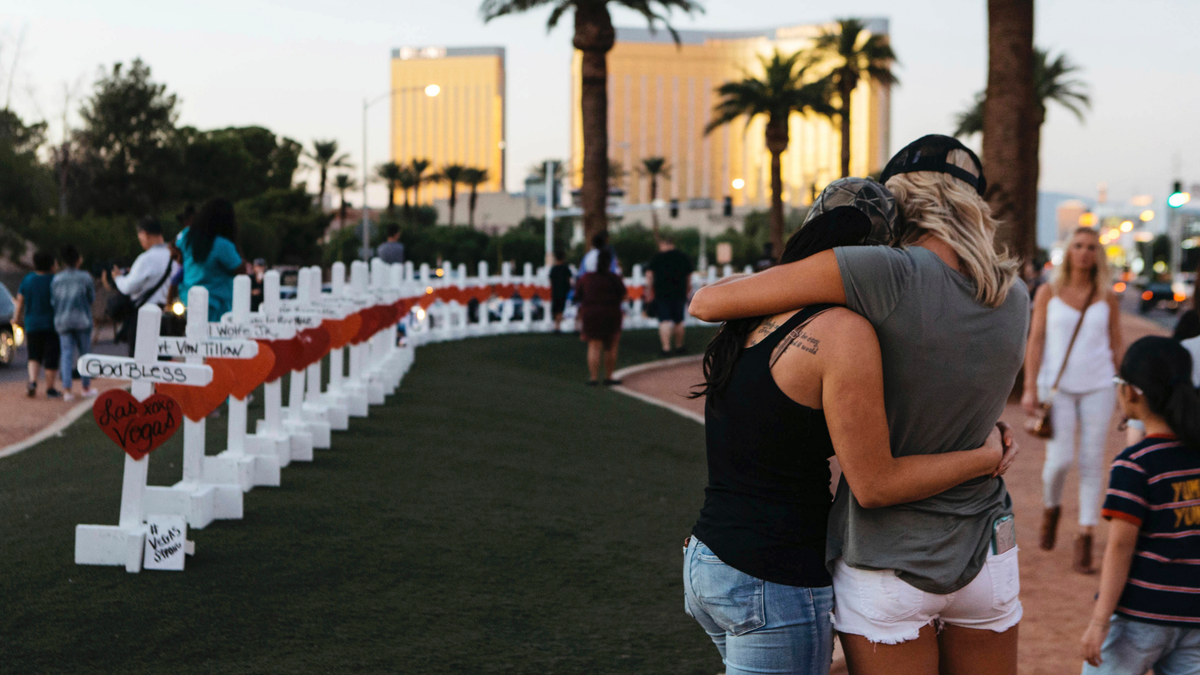
We live in an age of mass murders. Sometimes we can explain the carnage — the bloody outcome of a grievance, the casualties of terrorism — and sometimes we cannot.
But always, we are stricken. Even if we do not know the victims. Even if we are thousands of miles away from the gunfire.
Once again, we are mourning the victims of a gunman — 58 people who set out to listen to country music and wound up dead. And we wonder: Why is this happening? And how does it affect a society when repeatedly, streets and plazas and movie theaters and workplaces become blood-soaked battlefields?
There are no good answers.
"There's what we might call a natural post-traumatic stress disorder reaction," says Alan Lipman, a clinical psychologist and director of the Center for the Study of Violence in Washington, D.C.
"More and more, what we see is a kind of emotional numbing — an acceptance that this is part of the reality of life," and that nothing can be done to stop it, he says.
Mother Jones magazine and the Washington Post have counted the number of U.S. mass shootings since Aug. 1, 1966. They included killings in which four people or more died, but not gang murders or slayings linked to domestic disputes or other crimes, like robberies. The total: 948 dead in 131 shootings.
The 1966 date is not random. It was then that Charles Whitman, a 25-year-old architectural engineering major and ex-Marine, killed his wife, his mother and three others before climbing the 27 stories of a tower at the University of Texas and raining gunfire on the plaza below. Over 96 minutes, another 11 people were killed and 31 injured before Whitman was killed by police officers.
"I do not really understand myself these days," he wrote, in a suicide note. "I am supposed to be an average reasonable and intelligent young man. However, lately (I cannot recall when it started) I have been a victim of many unusual and irrational thoughts."
Some authorities would later blame his behavior on a pecan-sized tumor an autopsy found in Whitman's brain, though others disagreed — they said it was just a way of trying to explain the inexplicable.
There had been mass killings before the Texas sniper. In September 1949, 28-year-old Howard B. Unruh walked the streets of Camden, New Jersey, and killed 13 people with a gun he brought home as a souvenir from World War II. "I have a good mind," he insisted, but the justice system disagreed: He was found insane, and lived the rest of his 88 years in confinement.
"We can't understand it," New York Times reporter Meyer Berger quoted people in Camden as saying the day of Unruh's rampage. "Just don't get it."
In the decades since, Americans would have reason to express those same sentiments again and again, and the world they now live in has conspired to amplify already overwhelming events.
In 1949, media coverage of Unruh's rampage was rudimentary; Berger was deployed by train to Camden, a single reporter, and reported and wrote his account on deadline. He won a Pulitzer Prize for it.
When Stephen Paddock unleashed his mayhem in Las Vegas, 68 years later, multitudes of reporters and camera crews descended on the desert to cover the shootings, and the news plastered the internet and 24-hour cable news. There is no escape from an endless loop of blurry video of panicking concertgoers.
In fact, though the number of mass shootings has increased, they account for a vanishingly small percentage of all shooting deaths — less than 1 percent. And Steven Pinker, a Harvard professor of psychology and author of "The Better Angels of Our Nature: Why Violence has Declined," says there is far less violence today than in any era. Though it doesn't always feel that way.
Humans are resilient, and adaptive. Within view of The Associated Press headquarters in lower Manhattan, women push strollers under rows of trees, near two square holes in the ground. Water runs down their walls like tears for the nearly 3,000 people who died here 16 years ago.
And at the University of Texas, the observation deck of the tower where Charles Whitman perched reopened for good in 2004. In the garden beneath it, a monument is inscribed with the names of those who died more than a half-century ago, under a single Latin word: "Interfecti."
Killed.





















